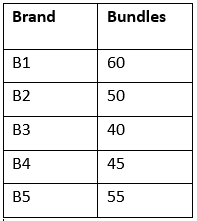Mathematics Question and Answer

On a certain sum of money, the simple interest for 2 years is ₹150 at the rate of 10% per annum. What is the difference between the compound interest and the simple interest for 2 years if, in the case of compound interest, interest is compounded annually at the rate of 10% per annum.
(A) ₹ 5
(B) ₹ 10
(C) ₹ 7.5
(D) ₹ 12.5
Correct Answer : C
The value of
(A)
(B)
(C)
(D)
Correct Answer : D
The following table shows the number of bundles of iron bars of 5 different brands sold from a shop during a given week.
The number of iron bars in each bundle of B1 and B3 is 5. The number of iron bars in each bundle of B2, B4 and B5 is 4. What is the total number of iron bars sold from the shop during that week of all the 5 brands taken together?
(A) 1100
(B) 1200
(C) 1150
(D) 1250
Correct Answer : A
If
(A)
(B)
(C)
(D)
Correct Answer : C
The price of sugar increases by 15%. By what percentage should the consumption of sugar be decreased so that the expenditure on the purchase of sugar remains the same? [Give your answer correct to 2 decimal places.]
(A) 11.11%
(B) 12.5%
(C) 14.16%
(D) 13.04%
Correct Answer : D
Explanation :
To solve this problem, let's denote:
- Initial price of sugar = P
- Initial quantity consumed = Q
- Initial expenditure = PQ
After the price increases by 15%, the new price becomes 1.15P.
To keep the expenditure constant, the new quantity consumed (let's call it Q') can be calculated using the formula:
New expenditure = New price × New quantity
Setting the new expenditure equal to the initial expenditure:
PQ = (1.15P) * Q'
Now, solve for Q':
Q' = PQ / (1.15P)
Simplify:
Q' = Q / 1.15
Now, let's find the percentage decrease in consumption:
Percentage decrease = [(Q - Q') / Q] * 100
Substituting the value of Q':
Percentage decrease = [(Q - (Q / 1.15)) / Q] * 100
Percentage decrease = [(Q * (1 - 1/1.15)) / Q] * 100
Percentage decrease ≈ [(1 - 0.8696) * 100] ≈ 13.04%
Therefore, the consumption of sugar should be decreased by approximately 13.04% to keep the expenditure on the purchase of sugar the same after a 15% increase in price.
Two craftsmen, A and B, are paid a total of ₹700 per week by their employer. If A is paid 250% of the sum paid to how much is A paid per week?
(A) ₹300
(B) ₹200
(C) ₹500
(D) ₹450
Correct Answer : C
If
(A)
(B)
(C)
(D)
Correct Answer : B
The cost price of 27 articles is the same as the selling price of 18 articles. What is the gain percentage?
(A) 50%
(B) 60%
(C) 90%
(D) 80 %
Correct Answer : A
Each side of a square is 12 cm long. The perimeter of this square is equal to the perimeter of a rectangle whose length is 16 cm. What will be the area of this rectangle?
(A)
(B)
(C)
(D)
Correct Answer : A




